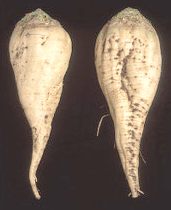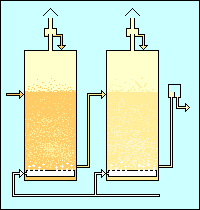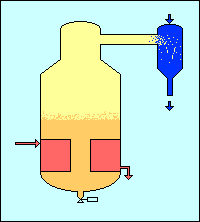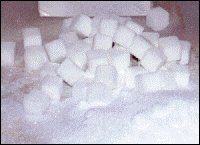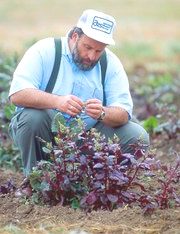|
SUGAR BEET CROPS |
||||||||||||||||||||||||||||||||||||||||||||||||||||||||||||||||||||||||||
|
HOME BIOLOGY CREW GEOGRAPHY HISTORY INDEX MUSIC FILMS THE BOAT SOLAR BOATS SPONSORS |
||||||||||||||||||||||||||||||||||||||||||||||||||||||||||||||||||||||||||
|
INTRODUCTION
Sugar beet (Beta vulgaris L.), is a member of the Chenopodiaceae subfamily and the Amaranthaceae family. It is a plant whose root contains a high concentration of sucrose. It is grown commercially for sugar. The sugar beet is directly related to the beetroot, chard and fodder beet all descended by cultivation from the Sea Beet.
The European Union, the United States, and Russia are the world's three largest sugar beet producers,[1] although only Europe and Ukraine are significant exporters of sugar from beet. Beet sugar accounts for 30% of the world's sugar production.
Left sugar beet is grown to be smoother than traditional beet to traps less soil
Culture
Sugar beet is a hardy biennial vegetable that can be grown commercially in a wide variety of temperate climates. During its first growing season, it produces a large (1–2 kg) storage root whose dry mass is 15–20% sucrose by weight. If not harvested, during its second growing season, the nutrients in this root are consumed to produce the plant's flowers and seeds. In commercial beet production, the root is harvested after the first growing season, when the root is at its maximum size.
Seed production and sugar production need to take place in different locations because frost resistance is poor, but plants need a cold shock to flower and produce seed. Requires a deep well drained stone free soil that is not acid. A high standard of management of land is needed to provide a well structured soil, free from compaction. Sowing date is quite crucial, early sowing gives better sugar yields due to increased water availability earlier in the season, but sowing too early leads to a high population of bolters. Seedling stage is a poor competitor with weeds and can be fatally damaged by millipedes, symphalids, spring tails and pigmy-mangel beetle. Beet cyst eelworm (Heterodera schactii) can be damaging and is only satisfactorily controlled by adequate rotation.
In most temperate climates, beets are planted in the spring and harvested in the autumn. At the northern end of its range, growing seasons as short as 100 days can produce commercially viable sugarbeet crops. In warmer climates, such as in California's Imperial Valley, sugarbeets are a winter crop, being planted in the autumn and harvested in the spring. Beets are planted from a small seed; 1 kg of beet seed comprises 100,000 seeds and will plant over a hectare of ground (1 lb will plant about an acre).
Up until the latter half of the 20th century, sugarbeet production was highly labor-intensive, as weed control was managed by densely planting the crop, which then had to be manually thinned with a hoe two or even three times during the growing season. Harvesting also required many workers. Although the roots could be lifted by a plough-like device which could be pulled by a horse team, the rest of the preparation was by hand. One laborer grabbed the beets by their leaves, knocked them together to shake free loose soil, and then laid them in a row, root to one side, greens to the other.
A second worker equipped with a beet hook (a short handled tool something between a billhook and a sickle) followed behind, and would lift the beet and swiftly chop the crown and leaves from the root with a single action. Working this way he would leave a row of beet that could then be forked into the back of a cart.
Today, mechanical sowing, herbicide application for weed control and mechanical harvesting has removed this reliance on workers.
Harvesting
Harvesting is now entirely mechanical. The sugar beet harvester chops the leaf and crown (which is high in non-sugar impurities) from the root, lifts the root, and removes excess soil from the root in a single pass over the field. A modern harvester is typically able to cover 6 rows at the same time. The beet is left in piles at the side of the field and then conveyed into a trailer for delivery to the factory. The conveyor removes more soil - a farmer would be penalised at the factory for excess soil in his load.
If beet is to be left for later delivery, it is formed into "clamps". Straw bales are used to shield the beet from the weather. Provided the clamp is well built with the right amount of ventilation, the beet does not significantly deteriorate. Beet that is frozen and then defrosts produce complex carbohydrates that cause severe production problems in the factory. In the UK, loads may be hand examined at the factory gate before being accepted.
In the US, the fall harvest begins with the first hard frost, which arrests photosynthesis and the further growth of the root. Depending on the local climate, it may be carried out in few weeks or be prolonged throughout the winter months. The harvest and processing of the beet is referred to as "the campaign," reflecting the organization required to deliver crop at a steady rate to processing factories that run 24 hours a day for the duration of the harvest and processing (for the UK the campaign lasts approx 5 months).
PROCESSING
Reception
After harvesting the beet are hauled to the factory. Delivery in the UK is by haulier or, for local farmers, by tractor and trailer. Railways and boats were once used in the UK, but no longer (some beet is still carried by rail in the Republic of Ireland).
Each load entering is weighed, and sampled before tipping onto the reception area, typically a "flat pad" of concrete, where it is moved into large heaps. The beet sample is checked for
From these the actual sugar content of the load is calculated and the grower's payment determined. The beet is moved from the heaps into a central channel or gulley where it is washed towards the processing plant.
Extraction
The diffuser is a large horizontal or vertical agitated tank in which the beets slices slowly work their way from one end to the other and the water is moved in the opposite direction. This is called counter-current flow and as the water goes it becomes a stronger and stronger sugar solution usually called juice. Of course it also collects a lot of other chemicals from the flesh of the sugar beet.
Diffusion
Diffusers are long (many metres) vessels in which the beet slices go in one direction while hot water goes in the opposite direction. The movement may either be by a rotating screw or the whole unit rotates and the water and cossettes move through internal chambers. There are three common designs of diffuser, the horizontal rotating 'RT' (from "Raffinere Tirlemontoise", the manufacturer), inclined screw 'DDS' (De Danske Sukkerfabrik)), or vertical screw "Tower". A less common design uses a moving belt of cossettes and water is pumped onto the top of the belt and pours through. In all cases the flow rates of cossettes and water are in the ratio one to two. Typically cossettes take about 90 minutes to pass through the diffuser, the water only 45 minutes. These are all countercurrent exchange methods that extract more sugar from the cossettes using less water than if they merely sat in a hot water tank. The liquid exiting the diffuser is called raw juice. The colour of raw juice varies from black to a dark red depending on the amount of oxidation which is itself dependent on diffuser design.
Pressing
The used cossettes, or pulp, exits the diffuser at about 95% moisture but low sucrose content. Using screw presses, the wet pulp is then pressed down to 75% moisture. This recovers additional sucrose in the liquid pressed out of the pulp, and reduces the energy needed to dry the pulp. The pressed pulp is dried and sold as animal feed, while the liquid pressed out of the pulp is combined with the raw juice or more often introduced into the diffuser at the appropiate point in the countercurrent process.
During diffusion there is a degree of breakdown of the sucrose into invert sugars and these can undergo further breakdown into acids. These breakdown products are not only losses of sucrose but also have knock-on effects reducing the final output of processed sugar from the factory. To limit (thermophilic) bacterial action the feed water may be dosed with formaldehyde and control of the feed water pH is also practised. There have been attempts at operating diffusion under alkaline conditions but the process has proven problematic - the improved sucrose extraction in the diffuser offset by processing problems in the next stages.
Carbonation
Next, carbon dioxide is bubbled through the alkaline sugar solution, precipitating the lime as calcium carbonate (chalk). The chalk particles entrap some impurities and adsorb others. A recycling process builds up the size of chalk particles, and a natural flocculation occurs where the heavy particles settle out in tanks (clarifiers). A final addition of more carbon dioxide precipitates more calcium from solution; this is filtered off, leaving a cleaner golden light brown sugar solution called thin juice.
Evaporation by Boiling
The thin juice, is concentrated via multiple-effect evaporation to make a thick juice, roughly 60% sucrose by weight, and similar in appearance to pancake syrup. Thick juice can be stored in tanks for later processing reducing load on the crystallization plant.
Crystallization
The thick juice is fed to the crystallisers, with recycled sugar dissolved into it, this is called "mother liquor". This is concentrated further by boiling under vacuum in large vessels and seeded with fine sugar crystals. These crystals grow as sugar in the syrup forms around them. The resulting sugar crystal and syrup mix is called a massecuite (French. 'cooked mass'). The massecuite is passed to a centrifuge where the liquid is removed from the sugar crystals. Remaining syrup is rinsed off and the crystals dried in a granulator using hot air.
The remaining syrup called is fed to another crystalliser from which a second batch of sugar is produced. This sugar ("raw") is of lower quality and is re-dissolved into the mother liquor. The syrup from the raw is also sent to a crystalliser and the very low quality sugar crystal that forms is also redissolved. The syrup separated is molasses; still containing sugar but with too many impurities to be economically processed.
There are variations on the above system, with different recycling and crystallisation paths.
GRANULATED PRODUCT
Sugar beet syrup
An unrefined sugary syrup can be produced directly from sugar beet. This thick, dark syrup is produced by cooking shredded sugar beet for several hours, then pressing the resulting sugar beet mash and concentrating the juice produced until it has the consistency similar to that of honey. No other ingredients are used. In Germany, particularly the Rhineland area, this sugar beet syrup is used as a spread for sandwiches, as well as for sweetening sauces, cakes and desserts.
History
Although beets have been grown as vegetables and for fodder since antiquity (a large root vegetable appearing in 4000-year old Egyptian temple artwork may be a beet), their use as a sugar crop is relatively recent. As early as 1590, the French botanist Olivier de Serres extracted a sweet syrup from beetroot, but the practice did not become common. The Prussian chemist Andreas Sigismund Marggraf used alcohol to extract sugar from beets (and carrots) in 1747, but his methods did not lend themselves to economical industrial-scale production. His former pupil and successor Franz Carl Achard began selectively breeding sugar beet from the White Silesian fodder beet in 1784. By the beginning of the 19th century, his beet was approximately 5–6% sucrose by weight, compared to around 20% in modern varieties. Under the patronage of Frederick William III of Prussia, he opened the world's first beet sugar factory in 1801, at Cunern in Silesia.
The development of the European beet sugar industry was encouraged by the Napoleonic Wars. In 1807 the British began a blockade of France, preventing the import of cane sugar from the Caribbean, and in 1813, Napoleon instituted a retaliatory embargo. By the end of the wars, over 300 beet sugar mills operated in France and central Europe. The first U.S. beet sugar mill opened in 1838.
Agriculture
Sugar beet is an important part of a rotating crop cycle. Sugar beet plants are susceptible to rhizomania ("root madness") which turns the bulbous tap root into many small roots making the crop economically unprocessable. Strict controls are enforced in European countries to prevent the spread, but it is already endemic in some areas. Continual research looks for varieties with resistance as well as increased sugar yield.
Power Consumption
Geneticist
checks beet plants for resistance to the fungal
disease
100kg fresh sugar beet can give 12 - 15kg sucrose, 3.5kg molasses, 4.5kg dried pulp and varying amounts of filter cake.
Source: FAO
Record
throughput at world leading facility in Norfolk Following
an extremely successful processing 'campaign',
the Wissington sugar factory near Downham
Market, recognised as the 'leading sugar beet
processing facility in the world', has now
established a new record throughput by
processing 20,023 tonnes of sugar beet in the 24
hour period to 6.00am this morning. Processing
around 2.4 million tonnes of UK grown sugar beet
every year, British Sugar's Wissington plant is
the largest and most efficient operation of its
type in the world. A
few beet sugar factories in Europe produce more
crystal sugar on a daily basis but none, say
British Sugar, process so much sugar beet in a
season, or produce so much sugar each year. As a
result, they cannot match the efficiency of its
UK operation. Some beet sugar factories in
Minnesota, USA come close but even with their
extended processing season, they don't beat the
UK's 'flagship on the fens'. Commenting
on the record at Wissington, operations director
Karl Carter pointed out, "It is the scale
of this and our other factories, coupled with
the innovative way we operate them, which makes
us the most efficient sugar producer in Europe.
We continually strive to increase the
efficiencies of all our operations and this
record throughput at Wissington has been
achieved by the determination and dedication of
the factory team, growers and hauliers." John
Smith, Communications Manager t:
+44 (0) 1733 422903
The
UK beet sugar industry produces 1.1 million
tonnes of sugar each year for the UK market -
just over half the country's requirements. The
remaining 1 million tonnes (just under half the
UK's requirements) are imported from developing
countries. British Sugar plc is the lowest cost producer in the EU 25. Sugar beet productivity in the UK, averaging almost 10 tonnes of sugar per hectare, is consistently ranked in the top 4 in the EU 25.
BRITISH SUGAR & BIOETHANOL
As one of the UK’s leading agri-processors with an interest in innovative new technology, British Sugar is planning to produce bio-ethanol in the UK.
We believe that the production and use of bioethanol as a transport fuel should play a central role in reducing carbon emissions into the atmosphere, allowing the UK to seize the opportunity presented by green technology to secure jobs and prosperity for the future.
BUYING BIOETHANOL
Corporate customers
Click here to request British Sugar sales literature.
Private customers
Q & A
Q:
What is the impact on carbon emissions of using
bioethanol as a fuel?
LINKS:
Solar Cola sponsor this website
We are looking for distributors in America, Australia, Canada, Europe, and Japan. The state of the Cola market globally and in the UK is ripe for a fresh quality brand, with excellent potential for growth. According to ResearchandMarkets.com the UK drinks market is worth an estimated £53.5 billion, representing a 7% share of total consumer spending. The global soft drinks market is roughly the same percentage of total consumer spending for developed countries.
Prospective investors in our company should consult their own independent investment advisers, and please note this information is provided for general guidance only. It is not a prospectus, but is provided in response to the number of requests we have received asking for more information
For all trade enquiries please contact: Nelson Kruschandl at:
Solar Cola UK or Solar Cola Exports The Old Steam House Herstmonceux, BN27 1RF United Kingdom
+ 44 (0) 1323 831727 +44 (0) 7905 147709
|
||||||||||||||||||||||||||||||||||||||||||||||||||||||||||||||||||||||||||
|
This website is Copyright © 1999 & 2006 NJK. The bird logo and name Solar Navigator and Solar Cola are trademarks. All rights reserved. All other trademarks are hereby acknowledged. Max Energy Limited is an educational charity. |
||||||||||||||||||||||||||||||||||||||||||||||||||||||||||||||||||||||||||
|
BLUEBIRD ELECTRIC CAR MANUFACTURERS ELECTRIC CARS ELECTRIC CYCLES SOLAR CARS |
